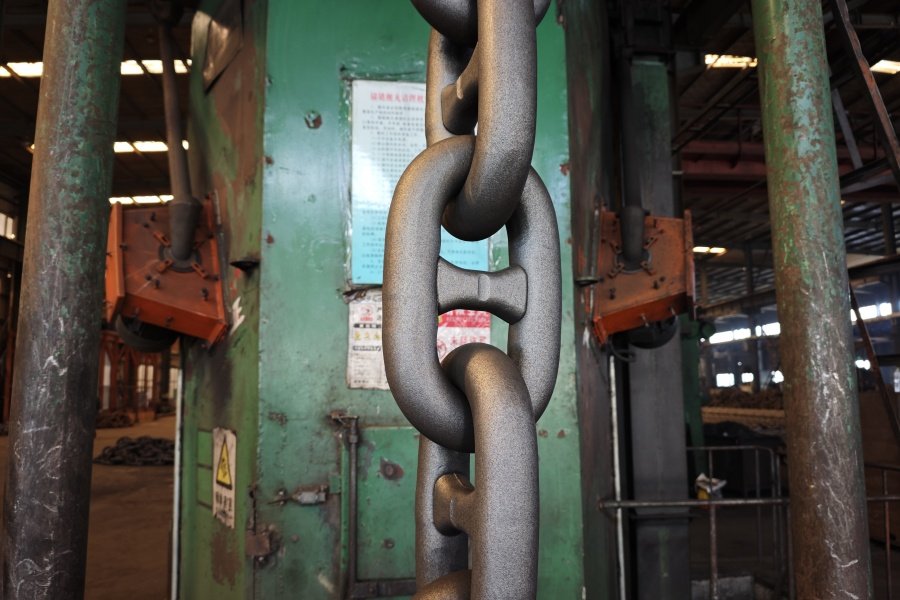Chain Brothers : Mooring Chain & Anchor Chain
Although anchor chain and mooring chain are often referred to together, they play different roles in marine engineering. The following is an analysis from the aspects of definition, use, material, structure, manufacturing process and standards:
Definition and Use of Mooring Chain & Anchor Chain:
Anchor chain:
It is a special chain that connects the anchor and the hull and transmits the anchor grip force. It is mainly used for ship mooring or submersible positioning. It can keep the ship stable when moored, prevent it from drifting due to natural forces such as water flow, wind and waves, and ensure the safe docking of the ship. For example, the chain length of each main anchor of a 10,000-ton ship is usually about 12 sections, and the standard length of each section of anchor chain is 27.5m. When anchored, the weight of the anchor chain itself can play a certain buffering role in the water against the wind and other external forces on the ship.
Mooring chain:
It is the core equipment for connecting offshore facilities with the seabed, used to fix ships, floating structures or marine engineering facilities in specific locations. Its biggest feature is that it is immersed in water for a long time, in the anchorage or mooring area, so that these objects can remain stable for a long time under various sea conditions to prevent drift or deviation. For example, in the fields of offshore oil extraction and marine engineering construction, mooring chains are important tools for fixing drilling platforms, oil production platforms, submarine pipelines and other facilities.

Material of Mooring Chain & Anchor Chain:
Anchor chain:
Usually made of high-strength steel or alloy materials such as M1, M2, and M3 grades to ensure that the anchor chain can withstand the impact and friction when the ship is under stress.
Mooring chain:
It is mostly made of bronze, copper alloy, stainless steel and other materials, such as R3, R3S, R4, R4S and R5 grades, because these materials have strong corrosion resistance and wear resistance and can adapt to long-term immersion in seawater environment. For example, R4 grade 22MnCrNiMo steel shows different wear forms under 3-13N loads. In the abrasive wear test, the wear amount under 3N load is 0.18mg, mainly plowing deformation; 3μm deep micro-cutting grooves are formed under 8N and 13N loads, accompanied by plastic deformation cracks.
Structure of Mooring Chain & Anchor Chain:
Anchor chain:
Generally a chain structure, the chain plate is usually thickened and welded from multiple iron plates to ensure strength. According to the structure of the chain link, it can be divided into two types: stud anchor chain and studless anchor chain, the former is stronger than the latter.
Mooring chain:
It is a single chain link or buckle type, the chain links are connected by buckles, the chain links are relatively small, but the number is large, and each chain link needs to have strong pressure resistance.
Manufacturing Process and Standards :
Anchor chain:
According to the manufacturing method, it can be divided into cast steel anchor chain and electric welding anchor chain. Welding anchor chain is currently widely used. The real turning point of its manufacturing process technology is the use of flash welding technology. The process is simple, the cost is low, and the quality exceeds other types of anchor chains.
Mooring chain:
China Classification Society specifications cover R3 to R6 technical standards, requiring 11 tests such as tensile, impact, and breaking load. R6 manufacturing includes four core processes: continuous heat treatment (880℃ quenching + 550℃ tempering), crossbar indentation detection (depth control 0.3 - 0.5mm), ultrasonic flaw detection (defect detection rate ≥99.6%), chain link welding (preheating temperature ≥150℃). The national standards implemented are GB/T 20848 - 2007, etc.
Conclusion:
The above is an analysis of the differences between SMEOCEAN's mooring and anchor chains. If you are interested in more information about standards or production processes, please contact us immediately. We will send you more brochures, standards, and the latest quotes. We look forward to hearing from you.


